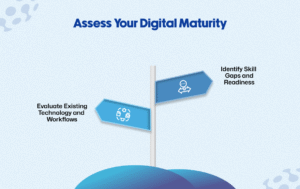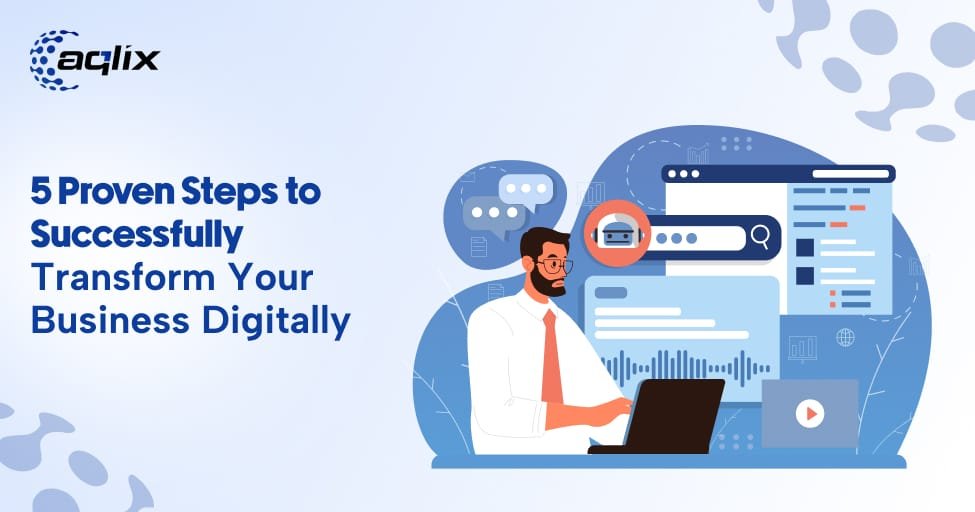Introduction
In our hyperconnected, data-driven world, digital transformation is no longer something your business does; it’s something that must be done to keep your business alive. Providers that don’t experiment with new models of care may eventually be left behind as their competitors increasingly rely on technology to deliver faster, smarter and more profitable care. Google Translate From migrating to the cloud, to tapping the power of AI – businesses today are being forced to change or get left behind.
But transformation isn’t simply hopping on the latest bandwagon of tools or platforms. It requires a strategy that disassembles it in stages that align technology to the company’s dreams. When programs stick to a roadmap, it shows transformation is what leads to sustainable value – not some short-term change fix.
This is the guide for you that includes Aqlix IT Solutions expert knowledge about how to build your business ready for going digital – one of today’s biggest buzzwords –as it doesn’t mean just new technology solutions, but also a change in culture and customer engagement.
Step 1: Assess Your Digital Maturity Now
It’s not completely alien concept and there are bigger ideas out there, but before moving to do something radical, you should get an idea of where your organisation is already. An honest assessment of your digital maturity sets the stage for an actionable and realistic roadmap. Exiting the Digital Sisyphus With a stepwise approach to emancipation you become transparent about the areas where technology can drive value.

Evaluate Existing Technology and Workflows
The first step is to reassess all of the tools, systems and processes we currently have at our disposal. Figure out what’s working well, what is obsolete and where inefficiencies need to be fixed. If, for instance, your data is locked in silos across disparate systems, you’ll be looking to modernize with offerings similar to integrated cloud platforms.
Identify Skill Gaps and Readiness
Technology alone cannot drive transformation. It needs to be staffed with individuals who have the knowledge and orientation necessary to make it work. Evaluate your team’s technical readiness, and decide where you’ll need training or hiring.
As a yardstick for apportioning investment and as a starting point in gauging progress, such an assessment is valuable. By plotting what they can do at the moment to steer themselves in the fontal direction, companies can journey their way to transformation success.
Step 2: Articulate Business Goals and Strategy
The digital revolution must be purpose-driven, not an end in itself. With a clear-cut strategy, everything decisions figure out is how to push broader business ambitions such as increased revenue, efficiency or an improved experience for customers.
Link Transformation to Business Outcomes
Express the results that your transformation should achieve in measurable format. Do you want to create authenticity and cust omer engagement through hyperpersonal experiences? Reduce operational costs through automation? So there should be a one-to-one relationship between every goal and the match KPI.
Ensure Leadership Alignment and Communication
‘When you invest in a business, it’s not just about looking at the financials – you’ve gotta meet the management. “Digi (digital) needs the leadership commitment from every level. When the leaders aren’t aligned, change work can become disconnected or run aground. Develop a shared vision and disseminate it throughout the organization to promote collaboration.
Step 3: Choose the Right Technology Stack
Your tech stack is your learnings so far and the structure that you’ve built for digital transformation. It’s the thing that determines how fast your business can innovate, scale and respond to change.
Align Tools with Strategic Needs
Select the technologies that match closest with what you are trying to achieve on your overall transformation—whether that’s cloud or AI-enabled analytics tools, automation or software as a service. Halt the constant chase of shiny new trends, technology or not. Instead focus on tools that actually solve problems and match up with your company’s digital roadmap.
Prioritize Scalability and Integration
The best modern businesses are built on systems that can scale up and be flexible. Choose solutions that easily integrate into your current environment and can be scaled as business grows. You, for example, will not be able to keep adding in–flight services without a dynamic cloud architecture.
Now, it is a time to make the most of resources as you can always get help from experts like Aqlix IT Solutions. Bespoke digital transformation plan to achieve your objectives and technology environment delivered by aqlix. Their approach to choosing a tech stack ensures that what you choose will stand the test of time.
Step 4: Step Up and Ratchet the Context in Which Processes Operate
Giving People Power to Do It Right Situated in western Massachusetts, Nuvo Bank (50 employees) found itself under pressure from a divide board that needed growth quicker and faster even though its processes were broken from left to right.
Culture and people are as essential to digital transformation as technology. How well can your staff respond to change and embrace innovation is largely what the future success depends on.
Invest in Training and Upskilling
Give your staff the training they need to feel comfortable utilizing new technology. Education is never-over Teach a constantly learning system – adaptation and change are less confusing as your team learns to make decisions using data, not guessing.
Create a Digital-First Culture
Write it and let the enhancements continue as is. Just collaborate, experiment, be open to new ideas! Let teams write better digital tools to drive their work and connect with customers more effectively. When the workers perceive transformation as an opportunity, rather than a problem for disruption, then they are your champions to success.
At Aqlix IT Solutions we believe in Centricity of People in all Transformation stories! Despite their determination towards the human, AMO organizations cannot only revamp their systems but can also lose a “digital-first” way of thinking altogether sides.
Step 5: MEASURE, OPTIMIZE, AND SCALE
Digital transformation isn’t a project you do and walk away from, it’s an effort of ongoing measurement, improvement and scaling. Continual improvement will make your systems evolve as market reality and customer needs change.

Establish Key Performance Indicators (KPIs)
Establish KPIs for measurement of the drive and performance. Such metrics as productivity, cost savings, customer satisfaction and time-to-market are used to gauge effectiveness of your digital campaigns.
Leverage Analytics for Continuous Optimization
It’s important to do data analytics to know what works and what doesn’t. Use what you learn to transform your processes, waste and decisions. Frequent reviews help to ensure that your change strategy is aligned with business aims and objectives.
Once metrics are achieved, you can start to scale, taking digital skills across one department or even an entire global operation. Building on a foundation of sustainable growth, turns the impacts from individual wins to transformation at an enterprise level.
In order for companies ready to grow big, Aqlix IT Solutions ensures full-scale digital growth. Their digital transformation services are designed to help organizations respond to constant change, adapt, and compete. To begin your journey toward digital excellence, contact us today and discover how Aqlix can accelerate your business growth.
Conclusion
Digital transformation isn’t just about an investment in technology, it’s the reinvention of everything your business does and how it delivers that value. By addressing each of the five steps independently, measure maturity levels, create clear targets, choose which (tech)logies to deploy, empower your people and optimize performance — genuinely transformative change can happen for businesses.
“At Aqlix IT Solutions, we believe that no business, whether it manufactures luxury yachts or has a workforce of just two people can afford not to have the most up-to-date technology available. Futuristic It is with this forward-looking attitude, digital strength and innovation that Aqlix creates With businesses to shorten and declutter their path to digitisation, laying the foundation for sustainable growth and success in the age of tomorrow.
Frequently Asked Questions (FAQ)
What is digital transformation?
A digital transformation is the integration of digital technology into all areas of a business. It changes the way that companies operate, add value and interact with their customers to lead change and be agile.
Why is digital transformation important for business?
It creates competitive pressure on businesses and makes them more efficient, better informed, a place customers want to be. For there is a lot hanging in the balance now for companies that can’t keep pace in an ever faster moving digital economy.
How long does digital transformation take?
That timeline will vary based on how large or complex the organization is, and what goal it is trying to achieve. It depends, but typically from a few months for small projects to several years for enterprise-wide transformation programs.
What Is The Role Of Leadership In Digital Transformation?
Leadership alignment is critical. Yet if implemented, that does require leadership to provide vision, resources and an organizational environment that can facilitate disruptive implementation in every department.
How Aqlix IT Solutions can help in your digital journey?
Aqlix IT Solutions Customized Digital Transformation Plans Custom built strategic digital culture transformation plans that suits our unique business needs. At each step in the process, their team is committed to ensuring that technology implementation results in demonstrable results and long-term scalability.



